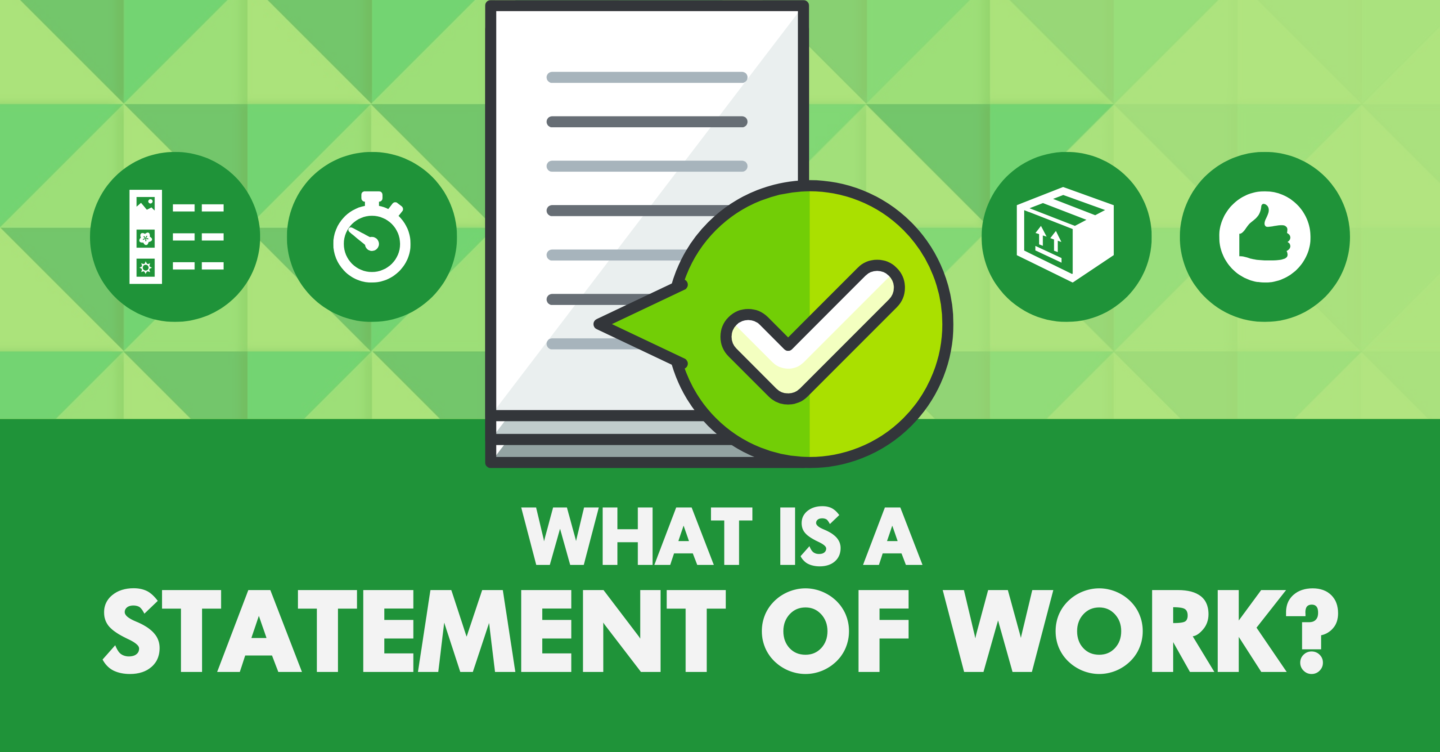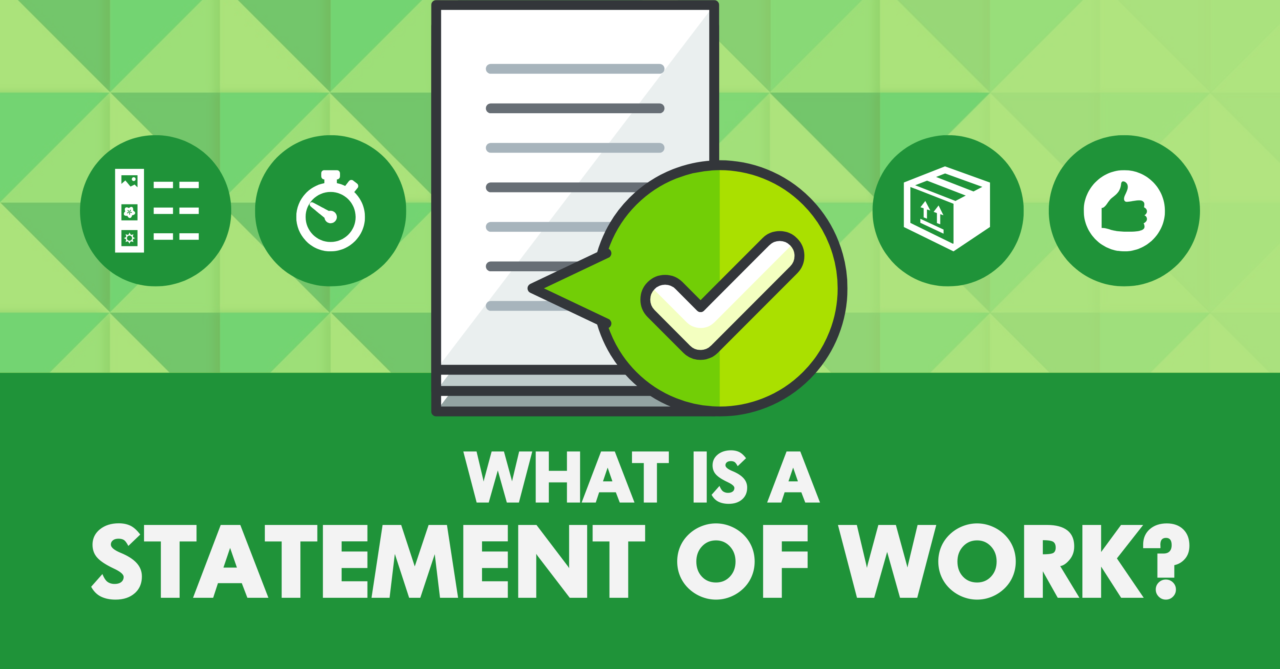What is a Statement of Work (SOW)?
A Statement of Work (SOW) is an integral part of an organization’s procurement process. It is a formal document that exists to provide direction to a vendor or contractor about how the work of a project is intended to be performed. In short, a SOW captures and defines all aspects of your project, laying the groundwork for your project plan.
Usually, it notes the activities, deliverables, and timetable for the project. It can be used to define the specific services expected from the contractor, the quality and level of said services, and also the pricing and standard regulatory terms and conditions of the work being done.
The Statement of Work is one of the first documents created in a project, laying out the landscape of the project before planning and execution begins. A well-written and effective SOW allows for increased control over the work being done.
How Do I Know I Need to Produce a Statement of Work?
A Statement of Work is an essential organizational tool intended to capture the work of the project in its entirety, stressing the elements that are critical to the project’s success.
A SOW is needed in two situations. The first, and more likely, situation is its role in the formation of part of a contract with an external vendor, consultant, or contractor. However, it can also be useful as an intermediate planning step for internal projects that are larger and more complex, requiring rigid organizational controls in order to be successful. When a project is large and complex, a well-written Statement of Work opens the door for the engagement of Subject Matter Experts in the type of work being performed, which ameliorates the success of the project’s outcome.
A Statement of Work is, at its core, a communications tool. It describes the work to be performed, and can be curated by anyone with written communication skills.
The Three Types of a Statement of Work
Design & Detail Statement of Work
This type of SOW explicitly outlines to the supplier how to do the job, defining the exact requirements needed for success. This could include precise measurements, the required materials, necessary tolerances, quality control requirements, and so on. In these SOWs, the author of the SOW bears the burden of performance risk, due to the explicit nature of the procedural instructions in the SOW.
Level of Effort, Time & Materials, Unit Rate Statement of Work
This type of SOW can be used for almost any kind of service-based contractual agreement. It includes the essential components of any Statement of Work, but its emphasis is on the time spent on the work, and the materials that are needed for the completion of the job.
Performance-Based Statement of Work
This is any Statement of Work that is used when the details about how the work needs to be accomplished are not included. This tends to be the preferred type of document for most organizations, due to the minimized risk of performance involved.
When Do I Write My Statement of Work?
In the planning stages of a project, the Statement of Work should be written after the Scope Statement has been clearly established. The Scope Statement is usually written first, capturing the intended outcome of the product in very broad terms, using the key language when necessary.
Simply put, the Scope Statement defines what it is that needs to be built. Once you know what needs to be built, the Statement of Work is then curated to outline the specific details of how you will go about building it. Since the SOW defines the work needed to be done, it must be written before any work can be scheduled.
Defining Success
An integral component of a successful Statement of Work is its clarity in defining success and failure. The SOW should function as a tool that effectively communicates to everyone involved in the project what constitutes success, as well as what constitutes failure. What this means is that while your central aim should be to adequately and clearly describe the work that is expected, you should also aim to establish the criteria that define when something is successfully completed or not. When this criterion is made abundantly clear, all moving pieces in a complex project work collaboratively towards a shared understanding of a successful outcome.

The Key Components of a Good Statement of Work
The information you provide in your Scope Statement should act as a guideline to the Statement of Work, meaning all elements captured should appear somewhere in the SOW, but in greater detail. For example, a Scope Statement can capture a project’s deliverables at a high level, but the Statement of Work contains these deliverables while also outlining their timeline, how they will be constructed, and so on.
The Scope of the Work
This is a mandatory component of a Statement of Work. This piece refers to including a detailed description of the work to be done, the tools to be used, and the exact nature of the work itself. This is usually where administrative work should be stipulated, which involves the work on the project deliverables. In this case, administrative work also includes project management work. (Note: if performing for an internal client, it is recommended to leave out project management outlines. However, it can be useful in establishing client expectations).
The Period of Performance
This is the second mandatory component of a Statement of Work. It is the portion of the SOW dedicated to stipulating the start and finish date for the project, as well as the maximum billable hours per time period, and any other logistical details referring to the length of time the project’s process is intended to cover.
The Deliverable Schedule
This is the final mandatory component of an effective Statement of Work. It stipulates the specific due dates for the project’s deliverables, for example, the completion dates for development. Here, it can be effective to outline the communication tools and frequency the stakeholders will be informed of the progress of the process, as well as requesting any schedule-based information needed from the team, such as intermittent progress reports.
The Location of the Work
This component is optional, applying only to Statement of Work’s produced for work that is performed anywhere other than the standard organizational location. This only needs to be stipulated a portion of the work is taking place off-shore.
Applicable Standards
This portion of the Statement of Work outlines the industry (or other) standards that are imposed on the project deliverables. This can include the restrictions of the International Organization for Standardization (ISO), the capability maturity model (CMM), the capability maturity model integration (CMMI), and any other applicable sets of standards.
Acceptance Criteria
This is the portion in which you highlight the specific quality standards that must be met by the contractor, as well as any other project-specific conditions that must be met.
Specialized Requirements
Similar to the Applicable Standards Requirements, this portion of the Statement of Work stipulates any specific qualifications that the workforce must have while accomplishing the project. For example, a PMP Certified Project Manager.
Challenges When Curating a Statement of Work
Due to the time-consuming and intricate nature of a Statement of Work, its production can be daunting. But, when you have a clear sense of the potential challenges involved in the writing of a SOW, you can prepare for them and work through them effectively. Some of the most common challenges faced when authoring a SOW include:
- Complexity: SOW’s are unique to each contract, meaning they vary significantly from one another, dependent upon the type of work required, the duration of the work, etc.
- Risks: a poorly-written SOW can lead to severe operational, financial, contractual, legal, and reputational risks, which can be daunting for its author.
- Expertise: there is short supply of writers who are qualified in recognizing the operational requirement of a compliant and enforceable SOW.
- Time: the SOW is written during the procurement process, which is often a period of urgency and priority for many organizations. This pressure of time hinders the development of an effective SOW, which is inherently a more time-consuming process.
- No Clear Direction: the lack of explicit guidelines and distinct rules and standards have many authors feeling misguided and lost in the process of creating a SOW.
Despite the obstacles outlined above, it is always important to strive for excellence when producing your Statement of Work. SOW’s are a key pillar in the foundation of an effective contract and are essential to productive project management. Keeping this at the forefront when curating a Statement of Work is essential, and by following the guidelines outlined above to the best of your ability, you can ensure optimal project performance and outcomes.
Strategies for a Well-Written Statement of Work
Include Clear Timetables
A good Statement of Work includes incremental deadlines for portions of the work, with some flexibility attached in order to account for the risk of error. It can also be useful to establish specific times for formal reviews, in order to ensure that all parties remain on track with one another towards success.
Establish Milestones
Defining when cumulative achievement occur can be an essential component for an organization’s morale when tackling a large and complex project. If needed, these established milestones can even be tied to payments, which gives clients and vendors incentive to continue timely and effective delivery.
Use Understandable Language
Statement of Work’s filled with industry-specific jargon may be tangible for you and for the vendor, but the audience of a SOW is likely to include more than just the service provider. The language used in a good SOW should be specific to the project, but not so complex that it interferes with a clear understanding by other parties, such as end-users, management, and even a judge.
Be Specific
In a good Statement of Work, specificity is key. This is especially true when describing the quality of work that is expected, when it is expected, how successes and milestones will be evaluated, and so on. If the language and stipulations are too broad, generic, or vague, it poses the risk of being misinterpreted, which could pose several risks for the organization. The more details provided, the stronger the SOW will be.
Final Thoughts
Achieving success in a project begins with defining it. When you detail the specific needs and precise expectations in writing at the beginning of a contractual relationship, well before the work begins, it enables all parties to follow your direction. An effective Statement of Work leads to an effective accomplishment of the work needed to be done, and ultimately results in an outcome acceptable to your standards of success.





